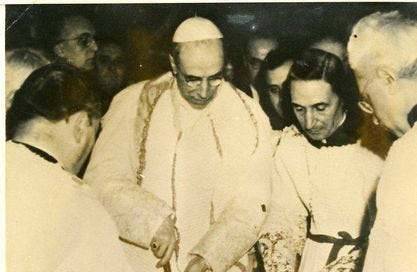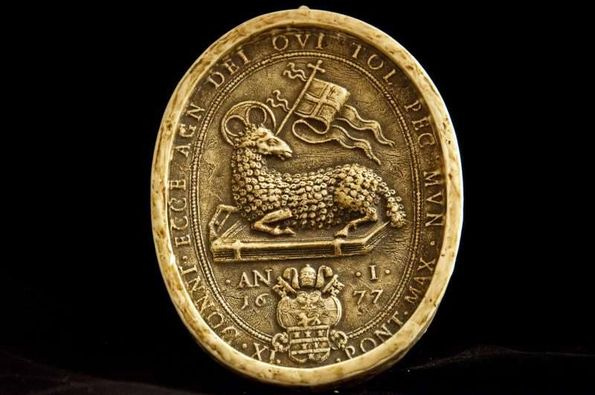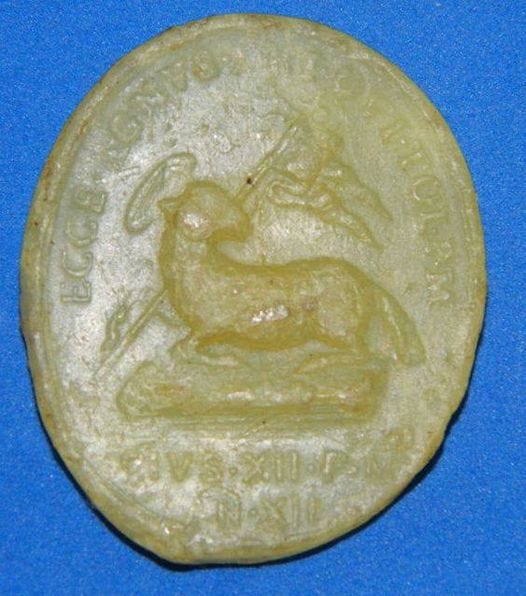Blessing of the Agnus Dei: From The Liturgical Year by Dom Prosper Louis Paschal Guéranger, O.S.B., 1904. (This last took place on April 1, 1964)
Blessing of the Agnus Dei: From The Liturgical Year by Dom Prosper Louis Paschal Guéranger, O.S.B., 1904. (This last took place on April 1, 1964)
.
The Wednesday of Easter week is the day set apart, at Rome, for the blessing of the Agnus Dei. This ceremony is performed by the Pope, the first and every seventh year of his pontificate. The Agnus Dei are discs of wax, on which are stamped, on one side the image of the Lamb of God, and on the other that of some saint. The custom of blessing them at Eastertide, is very ancient. We find traces of it in the liturgy, even so far back as the seventh century. When, in the year 1544, they opened at Rome the tomb of the Empress Mary (wife of Honorius, and daughter of Stilico), who died before the middle of the fifth century, there was found in it an Agnus Dei resembling those now blessed by the Pope.
It is, therefore, incorrect to state, as some authors have done, that the Agnus Dei originated at the time when the administration of Baptism at Easter fell into disuse, and that they were meant as symbols commemorative of the ancient rite. There is very little doubt that at Rome, each neophyte used to receive an Agnus Dei from the Pope, on Holy Saturday. We may, then, rightly conclude—and the conclusion is confirmed by the fact just mentioned, regarding the tomb of the Empress Mary—that the solemn administration of Baptism and the blessing of the Agnus Dei were contemporaneous, at least for a certain period.
The Agnus Dei are made from the Paschal candle of the previous year; of course, a great quantity of other wax is added to it. Formerly, it was the custom to pour in some drops of the holy Chrism. In the middle ages, the wax was prepared and stamped by the subdeacons and acolytes of the Pope’s palace; the Cistercian monks of the monastery of St. Bernard, in Rome, have now that honor.
.
The ceremony takes place in one of the rooms of the pontifical palace. A large vase of holy water is prepared; and the Pope, standing near it, recites the following prayer:
.
O Lord God, almighty Father, Creator of the elements, preserver of mankind, author of grace and eternal salvation! Who badest the rivers, that flowed from paradise, to water the whole earth! O Thou, Whose only-begotten Son walked dry-shod on the waters, and in the same was Baptized, Who also gave forth from His most sacred side water mingled with Blood, and commanded His disciples to baptize all nations; be merciful unto us, and pour forth Thy blessing upon us who celebrate all these wonders; that thus, the creatures which we are about to plunge into this water, may be blessed and sanctified by Thee, and that the honor and veneration, which shall be shown to them, may draw down upon us, Thy servants, the forgiveness of sins, pardon and grace, and finally life eternal together with Thy saints and elect.
.
After this, the Pontiff pours balm and holy chrism into the water, beseeching God to sanctify it for the purpose to which it is now to be used. He then turns towards the baskets which hold the waxen tablets, and recites this prayer:
.
O God, the Author of all sanctification, and Whose goodness is ever with us; Thou Who, when Abraham, the father of our faith, was preparing to slay his son Isaac in obedience to Thy commands, didst will him to consummate his sacrifice by offering up the ram that was entangled in the briers: Thou Who didst prescribe, through Thy servant Moses, the yearly sacrifice of the spotless lambs; deign, we pray Thee, to bless, and sanctify, by the invocation of Thy Holy Name, these forms of wax, which bear the impress of the most innocent Lamb; that by their contact and presence, the faithful may be incited to pray, storms and tempests be driven away, and the wicked spirits put to flight by the virtue of the Holy Cross hereon marked, before which every knee bends, and every tongue confesses that Jesus Christ, having conquered death on the gibbet of the Cross, now reigneth in the glory of God the Father. He it is Who, when led to death as a Sheep to slaughter, offered unto Thee His Father the sacrifice of His own Body, that He might bring back the lost sheep that had been led astray by the devil’s fraud, and carry it, on His shoulders, to the fold of heaven.
.
O almighty and eternal God, the institutor of the ceremonies and sacrifices of the Law, Who didst deign to turn away Thine anger from sinful men, as often as he offered victims of propitiation unto Thee; Who didst graciously accept the sacrifices made by Abel, Melchisedech, Abraham, Moses and Aaron, which sacrifices were indeed but figures, yet, by Thy blessing, were made holy and profitable to them that humbly offered them; grant, we beseech Thee, that as the innocent Lamb, Jesus Christ Thy Son when immolated at Thy will on the altar of the Cross, delivered our first parent from the power of the devil, so may these spotless lambs, which we present to Thy divine Majesty for a blessing, be endued with power unto good. Deign to bless them, to sanctify them, to consecrate them, to give them the power to protect those who devoutly carry them against the malice of demons, against tempests, pestilence, sickness, fire, and enemies; and make them efficacious in protecting the mother and her child, in the dangers of travail. Through Jesus Christ, Thy Son, our Lord.
.
After these prayers, the Pope girds himself with a cloth, and sits near the vessel of holy water. The ministers bring him the Agnus Dei, which he plunges into the water, in imitation of the Baptism of the neophytes. The prelates who are present take them from the water and place them upon tables covered with white linen. Then the Pontiff rises, and says the following prayer:
.
O Holy Spirit! Who makest the waters fruitful, and usest them as the instrument of Thy greatest mysteries; Who didst take away their bitterness, and give them sweetness; and, sanctifying them by Thy breathing, dost employ them for washing away all sins, by the invocation of the Holy Trinity; vouchsafe to bless, sanctify, and consecrate these lambs that have been cast into the holy water, and have imbibed of the balm and holy chrism. May they receive power from Thee against the efforts of the devil’s malice; may they who wear them abide in safety; may they have nought to fear from danger; may the wickedness of men have no power to hurt them; and do Thou mercifully be their Strength and Consolation.
.
Lord Jesus Christ, Son of the living God! Who art the innocent Lamb, the Priest and the Victim; Whom the prophets called the Vine and the Corner Stone; Who didst redeem us by Thy Blood, and, with that same, didst sign our hearts and foreheads, that the enemy, when passing our dwellings, might not wreak his anger upon us; Who art the spotless Lamb, offered in ceaseless sacrifice; Who art the Paschal Lamb, become, under the sacramental species, the remedy and salvation of our souls; Who guidest us across the sea of this present life to the resurrection and glory of eternity; deign, we beseech Thee, to bless, sanctify, and consecrate these spotless lambs, which, in Thy honor, we have formed out of virgin wax, and have impregnated with holy water, and sacred balm and chrism, intending hereby to commemorate Thy being divinely conceived by the operation of the Holy Ghost. Protect those that wear them from fire, and lightning, and tempests, and every adversity; grant them to be a safeguard to mothers in the pains of childbirth, as Thou didst assist Thine own when she gave Thee birth. And as Thou, heretofore, didst save Susanna from her false accusers, and the blessed martyr and virgin Thecla from torture, and Peter from his prison chains; so, now, vouchsafe to deliver us from the dangers of this world, and give us to merit life eternal with Thee.
.
The Agnus Dei are then respectfully taken, and kept for the solemn distribution to be made on the following Saturday. It is not difficult to see how this ceremony bears on the Pasch; the Paschal Lamb is frequently mentioned, and the plunging of these sacred images into the water is an evident allusion to the administration of Baptism, which, for so many centuries, was a prominent feature of the Easter Octave. The prayers, which we have somewhat abridged in our translation, are not of a very ancient date; still, the rite which accompanies them, refers implicitly to Baptism. As we have already remarked, the custom of blessing the Agnus Dei was observed several centuries before the abolition of the solemn administration of Baptism at Easter; and is an additional proof of the fervent devotion wherewith the Church has ever honored the mystery of the Lamb at Eastertide.
On account of their sublime symbolism, their being blessed by the Sovereign Pontiff, and the solemnity of their rite, the Agnus Dei are considered as one of the most venerated objects of Catholic piety. They are sent from the holy city to every part of the world. The faith of those who respectfully keep them in their houses, or wear them, has frequently been rewarded by miracles. During the Pontificate of St. Pius V, the Tiber overflowed its banks, and threatened destruction to several quarters of the city: an Agnus Dei was thrown into the river, and the water immediately receded. This miracle, which was witnessed by several thousands of the inhabitants was brought forward in the process of the beatification of this great Pontiff.






I've heard it's taken place since 1964 including most recent pontificate. I've seen photos but I am not sure if information is correct.